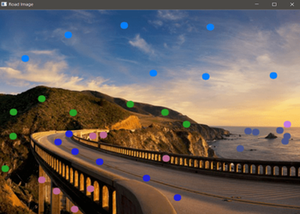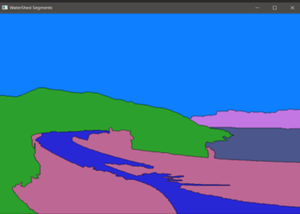Este artículo analiza cómo podemos detectar contornos dinámicamente al hacer clic en la imagen y asignar diferentes colores a diferentes partes de la imagen. Los contornos son una herramienta muy útil para el análisis de formas y la detección y reconocimiento de objetos. Este programa utiliza las bibliotecas OpenCV , Numpy y Matplotlib . También utiliza un algoritmo OpenCV Watershed incorporado para detectar contornos.
Requisitos
- Python y OpenCV deben estar instalados en la máquina local.
- Instale Jupyter Notebook para una fácil depuración.
- Aquí, el mapa de colores de Matplotlib se usa para obtener diferentes colores. En el ejemplo dado a continuación, usaremos tab10. Puede elegir diferentes mapas de colores. Consulte este sitio para ver los diferentes colores.
Explicación
- Ejecuta el programa.
- Haga clic en la imagen donde desea hacer los contornos.
- Seleccione un color diferente para una parte diferente de la imagen presionando números del cero al nueve. (Un número para un color)
A continuación se muestra la implementación.
Python3
# Import modules
import cv2
import numpy as np
import matplotlib.pyplot as plt
from matplotlib import cm
# Upload the image in the same directory and then run the code
# If image not found you may get an error
# Reading Image
road = cv2.imread('road_image.jpg')
# Making Copy of Image
road_copy = np.copy(road)
# Creating two black image of same size as original image
marker_image = np.zeros(road.shape[:2], dtype=np.int32)
segments = np.zeros(road.shape, dtype=np.uint8)
# Function to return tuple of colors
def create_rgb(i):
x = np.array(cm.tab10(i))[:3]*255
return tuple(x)
# Storing Colors
colors = []
# One color for each single digit
for i in range(10):
colors.append(create_rgb(i))
# Global Variables
# Color Choices
# Number of markers
no_markers = 10
# Current markers
current_marker = 1
# Flag
marks_updated = False
# CALLBACK FUNCTION
def mouse_callback(event, x, y, flags, param):
global marks_updated
if event == cv2.EVENT_LBUTTONDOWN:
# TRACKING FOR MARKERS
cv2.circle(marker_image, (x, y), 5, (current_marker), -1)
# DISPLAY ON USER IMAGE
cv2.circle(road_copy, (x, y), 5, colors[current_marker], -1)
marks_updated = True
# Naming the window and setting call back function to it
cv2.namedWindow('Road Image')
cv2.setMouseCallback('Road Image', mouse_callback)
while True:
# Show the 2 windows
cv2.imshow('WaterShed Segments', segments)
cv2.imshow('Road Image', road_copy)
# Close everything if Esc is pressed
k = cv2.waitKey(1)
if k == 27:
break
# Clear all colors and start over if 'c' is pressed
elif k == ord('c'):
road_copy = road.copy()
marker_image = np.zeros(road.shape[0:2], dtype=np.int32)
segments = np.zeros(road.shape, dtype=np.uint8)
# If a number 0-9 is chosen index the color
elif k > 0 and chr(k).isdigit():
# chr converts to printable digit
current_marker = int(chr(k))
# If we clicked somewhere, call the watershed
# algorithm on our chosen markers
if marks_updated:
marker_image_copy = marker_image.copy()
cv2.watershed(road, marker_image_copy)
segments = np.zeros(road.shape, dtype=np.uint8)
for color_ind in range(no_markers):
# COLORING SEGMENTS
segments[marker_image_copy == (color_ind)] = colors[color_ind]
marks_updated = False
# Destroy all the windows at the end
cv2.destroyAllWindows()
Producción:
Este código abrirá dos ventanas. Uno con la imagen original y otro negro. Al hacer clic en la imagen original, se crearán pequeños círculos en ella y los contornos se mostrarán en la imagen negra. (Presione los números del 0 al 9 para cambiar los colores y producir un gráfico de contorno diferente).

Imagen original

Imagen procesada
Publicación traducida automáticamente
Artículo escrito por adityapande88 y traducido por Barcelona Geeks. The original can be accessed here. Licence: CCBY-SA